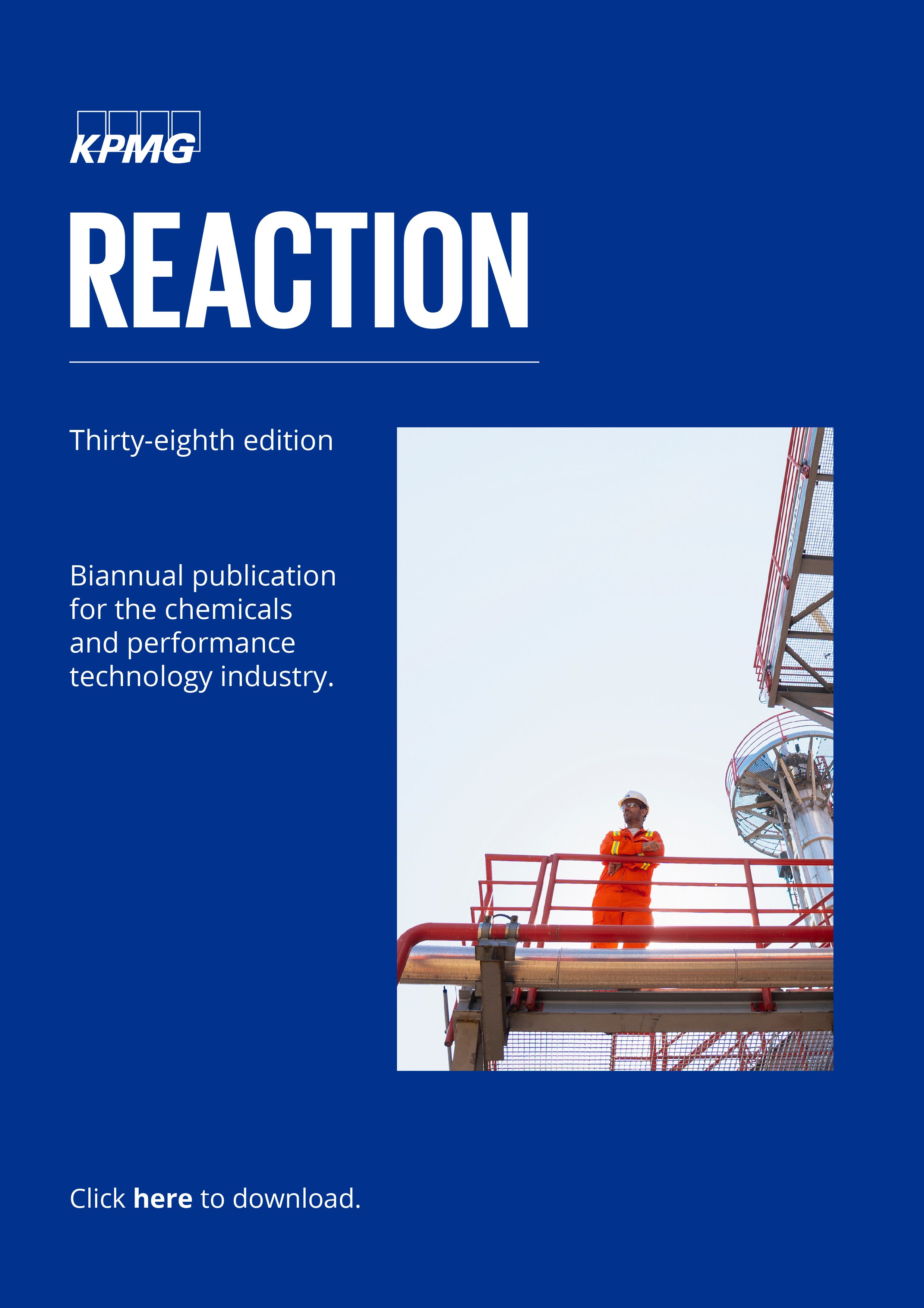By: Asad Akram, Manager, Strategy, KPMG in the US; Chiara Catgiu, Manager, Sustainability & Climate Changes Services, KPMG in Italy; and Ed Middleton, Partner, Energy and Natural Resources and Private Equity, KPMG in the UK.
As the world strives to meet net zero targets, the chemicals sector has a key role to play, by reducing its emissions and helping other sectors do the same.
The very nature of the processes within chemicals makes it a significant producer of CO2. In 2021, direct CO2 emissions from primary chemical production were 925 Mt, a 5 percent increase on 2020 levels. Chemicals are the third largest emitter amongst all industrial sectors – and if the chemicals sector were a country, it would be the fifth largest emitter of direct CO2 in the world.1
Notwithstanding its own high carbon output, the sector has significant relevance to the carbon footprints of many other industries. Over 95 percent of manufactured products rely on chemicals, making the sector a considerable Scope 3 factor for other businesses.2 Reducing the carbon emissions of the chemicals process would have a substantial positive impact beyond the industry itself.
Decarbonization has been a live agenda item for some time, and the chemicals sector has been making considerable efforts to advance sustainability. The industry has long adopted leading practices around safety processes and the protection of the environment. It has
implemented advanced systems in areas such as wastewater recycling. It increasingly embeds cuttingedge technologies into processes to maximize safety and minimize environmental impact.
But like a host of other sectors, there’s no question that taking carbon and other gases like methane out of the footprint at the scale (and speed) needed presents a challenge. Chemicals are notoriously hard to decarbonize, not least because much of the feedstock it uses comes from fossil fuels. At the same time, about a third of its carbon emissions are inherent in the chemical reactions required to produce compounds like ammonia and petrochemicals.3 More large-scale technological investments are needed for fuel and process emissions to be reduced on a large scale.
As the net zero agenda increases in strategic priority, there is growing pressure on chemicals companies from governments, regulators, investors, NGOs, and other stakeholders to develop credible and detailed energy transition plans. The window for doing this is now – because only if real momentum is established this decade will the various targets set for 2030 and beyond remain feasible.
Given the urgency – and the size – of the issue, how can chemicals businesses best drive a decarbonization strategy that will deliver the needed transformation?

Three lenses
This piece will look at the issue from three essential perspectives:
- Firstly, it will consider how the chemicals industry can reduce emissions. This remains the overriding strategic priority.
- Secondly, it will also consider how chemicals businesses can help enable the production and adoption of renewable energy more widely. This is to the potential benefit of all business sectors and communities at large.
- Thirdly, it will examine how chemicals can enhance energy and material efficiency and benefit the value chain.
This article will then conclude by briefly considering other aspects, such as the broader ESG agenda and the regulatory landscape.
1 Reduction of own emissions
As a highly energy-intensive industry, reducing the GHG impact of the energy the chemicals sector uses – and using less – is crucial to the transition. Ultimately, success will likely lie in a combination of a reduction in both fuel emissions and process emissions.
Fuel emissions
For fuel, this means moving to renewable energy (RE) sources wherever possible instead of conventional fossil-fuel-derived electricity and gas. To a significant extent, the chemicals industry depends on the decarbonization and transition progress of the energy sector from which it draws its supply.
The growth in energy generation from wind and solar is encouraging – but may not be enough on its own. Alternative fuel sources are needed – one of which is hydrogen. This has vast potential as a clean fuel source to replace oil and conventional gas – whether blue or grey in the short term or potentially green in the medium term.
Green hydrogen is expected to break even with grey hydrogen in terms of its levelized cost by 2030.4 But there are some uncertainties here. Certain key factors are expected to primarily drive an acceleration in the reduction of the cost of green hydrogen:
- Faster scale-up of electrolyzers and increasing investments in renewable power globally will decrease Capex requirements.
- Plans of large-scale RE projects which will offer high utilization rates for electrolyzers.
- Declining levelized cost of energy (LCOE) of RE.
Therefore, how far and fast green hydrogen becomes commercially attractive at scale remains to be seen. Some observers believe a mixture of natural gas, blue hydrogen and carbon capture storage is the most viable route forward. Whatever the case, the chemicals sector needs to partner up and down the value chain to enable and accelerate the transition.
A further cornerstone of the net zero roadmaps could be small modular reactors to generate power and process heat if governments are willing to provide approvals. These are smaller than traditional nuclear reactors, typically producing less than 1,000 MWth (thermal) or 300 MWe (electric). Compared to conventional reactors, they are expected to be safer, more efficient and require less on-site construction, reducing financial and safety barriers to nuclear reactors. The US DoE has supported SMRs since 2012. Still, several technical and regulatory obstacles must be overcome to be widely adopted – including safety, waste management, the regulatory framework for nuclear energy and preventing nuclear proliferation.
LCOE: US$ 65/MWh vs. US$129-198 for an unsubsidized new conventional nuclear, 80-85 percent of which is CAPEX.
However, chemical businesses should do more than wait for solutions from their power-generation cousins. A significant and growing array of new methods and technology options need to be explored, invested in, and developed at a pace to facilitate an energy transition.
A key area for chemicals businesses to develop is biomass and alternative feedstocks to use in steam crackers and other chemicals processes derived from renewable sources such as agriculture waste, forest residues, energy crops and algae. If these can be brought to commercial scale and viability, it could break the dependence on fossil fuel feedstock and significantly lower the carbon footprint. Some commercial-scale bio-refineries already convert biomass feedstocks, such as sugar and lignocellulosic materials to chemicals and energy (biofuels, power, and heat). However, further development and scaling up require additional research and policy support.
Another promising advancement is petrochemical producers' growing use of pyrolysis oil (pyoil) – pyoil can be produced from plastic waste through advanced recycling. It can potentially become a truly 'circular' element of the petrochemical industry.
Further, the industry should continue to invest in equipment electrification, including steam crackers. Steam crackers have become the foundational facility for the chemical process – so electric solutions need to be a priority for development, even if they are more likely a medium-term than short-term reality. Work here is expected to be a combination of retrofitting existing steam crackers to convert them to electric and of building a new generation of 'e-cracking' systems. In addition to being greener, e-cracking will lead to efficiency and flexibility gains as electric heating can be more precise and responsive than steam-based systems. Dow, Shell and two other partners are already collaborating to develop this technology in their operations, including receiving some funding from the Dutch government. They plan to pilot retrofitting existing crackers by 2025, and a new e-cracker is expected by 2027.5

There are barriers to be overcome. Electric heating systems typically require significant amounts of electricity, which can be expensive and may require upgrades to local power grids. They may also require substantial modifications to existing steam cracker infrastructure which can be costly and time-consuming.
A less considerable, but still significant, aspect of the chemicals sector’s fuel emission footprint centers on mobility, logistics and distribution. As with other industries, chemicals businesses need to invest in green fleets of low-emission vehicles, greener enabling infrastructure, and logistics optimization to reduce mileage and environmental impact. AI and data and analytics technology have a significant role in facilitating this smart logistics approach.
Process emissions
As well as addressing the power sources for chemicals processes as discussed above, it will also be essential to achieve process intensification through new techniques that require less energy and resources, resulting in lower emissions. A range of factors, including microreactors, process optimization and the integration of chemical processes, can enable this. It's an area where advanced catalysts will also help, increasing the efficiency of existing processes and supporting the switch to renewable feedstocks such as ammonia and CO2. The impact could be as high as 1.0-1.8 GtCO2eq by 2050.6
Meanwhile, just as AI and ML can help drive smarter logistics, as discussed above, they can also make a difference to process efficiency – by predicting the behavior of chemical reactions helping to optimize process conditions to minimize emissions.

Resource stewardship
Alongside the reduction of fuel and process emissions, resource stewardship also has a vital role to play.
Flaring to burn away off-gases still occurs in the chemicals and other industrial sectors. Every year 144bn cubic meters of natural gas is flared – enough to power sub-Saharan Africa.7 Small-scale, modular gas utilization technologies can help reduce flaring-based emissions.
Carbon capture, utilization, and storage (CCUS) is a further important area. Captured CO2 can be used as a feedstock itself to produce chemicals. Captured CO2 can be used as a feedstock to produce chemicals, for example, by converting carbon emitted as CO2 during the production process into liquid fuels such as methanol. A barrier here is the high capital cost of carbon capture technology — but, like green hydrogen, the hope is that these costs will fall as new techniques are developed. The scaling of CCUS brings the investment required down to commercially viable levels.
Finally, the development of the circular economy holds significant potential. This is discussed more fully in section 3.
A barrier here is the high capital cost of carbon capture technology — but, like green hydrogen, the hope is that these costs will fall as new techniques are developed.
2 Enabling renewable energy
The chemicals sector plays a vital role in enabling the production of renewable energy infrastructure, such as adhesives and silicon carbide, in the technical ceramics of wind turbines. PFOA (Perfluorooctanoic Acid) and PFOS (Perfluorooctanesulfonic acid), the most common of the PFAS “forever chemicals” family, are required components in every significant industrial electric membrane used in hydrogen production – both are in the process of being banned in the US and EU, which necessitates further collaboration between industry and government. The industry needs to continue to enable improvements in renewable energy by producing lighter, cheaper, and better material components of the energy transition.

With batteries for EVs set to move into mass production as the world moves away from internal combustion engines, this would make a considerable contribution to the low-carbon future. Some chemicals could also be a key component in new, cleaner battery technologies, such as lithium-iron-phosphate (LFP), replacing the dependence on critical minerals such as cobalt and nickel.
There are also important initiatives and coalitions helping to develop low-carbon technologies, such as Low-Carbon Emitting Technologies (LCET) and the Mission Possible Partnership (MPP). LCET is a collaboration of ten major chemicals companies and 70-plus senior chemicals executives with the World Economic Forum (WEF) to develop the upscaling of low-carbon technologies and accelerate progress towards net zero by 2050. It involves collaboration with policymakers, value chain partners and financial institutions to:
- Identify policies that support the deployment of LCET
- Develop R&D in low-carbon strategies
- Develop finance gap models for optimum finance allocation
As part of the MPP initiative (a partnership amongst hard-to-decarbonize industries, including transport and heavy industries), LCET is also developing transition strategies in two key value chains in the chemicals sector that contribute to 44 percent of its emissions:
- Olefin production
- Ammonia production
3 Contributing to greater energy efficiency
As was mentioned earlier, the chemicals sector can lead in developing the circular economy and material recovery as a BAU operational model. This has the double potential benefit of lowering consumption of the world’s resources and reducing the energy needed to process or convert them into other products and substances.
Globally, only 7.2 percent of our world is circular.8 Resource consumption is projected to increase two-fold by 2050 compared to 2020, underlining the issue's urgency.
In the chemicals sector, circular economy approaches will see mechanical recycling, which often leads to downcycling (value loss), moving to chemical recycling which enables upcycling (added value). The broader development of circular economy techniques can significantly decarbonize the chemicals sector by changing the business model to decouple economic growth from chemical consumption.
Three key principles lie behind the circular economy, all driven by design:
Globally, only 7.2 percent of our world is circular. Resource consumption is projected to increase two-fold by 2050 compared to 2020, underlining the issue's urgency.

For chemicals, eliminating waste and pollution can be achieved by transitioning from fossil fuel-based feedstocks to renewable, recycled or bio-based feedstocks. This lowers the carbon footprint and avoids waste at the end of product life. It also avoids toxic chemicals being used in the first place, further contributing to sector decarbonization and safety.
There is increasing investment in circulating products and materials such as pyoil from plastic waste, recycled oil, and recycled/sustainable polymers. New plastic materials made from recycled polypropylene (PP) are also being developed for use in industries such as automotive. Bio-based, compostable, and recyclable bioplastics are another big growth area, with businesses such as Total Energies and Novamont investing in their production.
Another hot area for investment is bio-based chemicals, which include fermentation products such as ethanol, lysine and citric acid, sorbitol, and glycerol, as well as pine chemicals and bio-diesel (which can be used as a sustainable aviation fuel). Bio-based chemicals can significantly lower GHG emissions – for example, compared to fossil fuel-based methanol, renewable methanol results in a reduction of up to 95 percent.9
One vehicle for this is chemical leasing or the chemicals-as-a-service concept whereby instead of providing a customer with a batch of chemicals, some of which may go to waste, the chemicals business gives them only the right amount – and takes the chemical leftovers back. A good example of this is in the textiles industry. A quarter of the world's chemicals are used for textile production, and it is estimated that over 8,000 chemicals are used to turn raw materials into textiles.10 Increased initiatives to take chemicals back to be reused, recycled or disposed of in an environmentally responsible manner by the chemicals supplier can make a significant impact, therefore.11
The third principle of regenerating natural systems is focused on the increased use of compostable plastics and materials – but it also centers on using regenerative materials in the first place and directing them back into the ecosystem where possible. Alongside this, there is a growing interest in using bio-based substances instead of chemically produced ones for coloring garments.
In addition, the chemicals industry can play an important role in enabling energy efficiency across other sectors through the development of new and innovative materials, such as lighter-weight composite materials for use in the construction of buildings and the manufacture of cars, planes and other assets, reducing the amount of energy used both in their production and their working life.
4 Other key parts of the value chain
It is not only about energy usage and consumption, however. The broader ESG agenda has become a central corporate priority across sectors as stakeholders look to businesses to embrace ethical, equitable and sustainable values across all aspects of their operations.
These take in a wide range of areas – from protecting biodiversity and ensuring careful management of hazardous waste and water; to product safety, employee health and safety and the promotion of inclusion and diversity amongst the workforce, and community relations to increase engagement with local communities and social groups who may be concerned about the health and safety issues and environmental impacts of any proposed chemical operations in their locality.

There is a complete and stretching agenda – which chemicals businesses must embrace and meet head-on to retain their license to operate and the trust and confidence of the wide range of stakeholders they interact with and depend upon.
5 The regulatory landscape
Alongside all the factors already discussed, another critical part of the picture is the regulation being introduced to encourage, incentivize, and, where necessary, force businesses to adopt low-carbon and sustainable practices.
Some of these regulatory initiatives are, in fact, full of opportunities for chemicals – such as the Inflation Reduction Act (IRA) in the US. See Chemicals enter a new era of green investment for a complete discussion of IRA and the regulatory landscape in other key jurisdictions, such as the EU.
In addition, the notion of extended producer responsibility (EPR) is growing and may begin to be enshrined in regulation in some parts of the world. This sees the manufacturers and suppliers of products such as chemicals being tasked with the responsibility for collection and disposal/remediation of the goods they produce.
In response to the evolving regulatory landscape and to help maximize opportunities and protect against downside risks, chemical businesses should actively keep informed. KPMG professionals recommend the following actions:
- Horizon scanning: To help prevent any roadblocks to chemical production, companies should establish measures to anticipate and respond to any upcoming regulations and policies in respective geographies.
- Policy scenarios: One of the primary elements in developing a transition plan at the sector level includes conducting policy scenario analysis, which involves incorporating present regulations and potential future policies. Chemicals companies need to consider the policy environment in the countries they operate in, source raw materials from, make sales in, and find the risks and opportunities associated with transitioning to low-carbon production.
- Opportunities: Investing in low-carbon measures can bring many options, such as creating new carbon markets, enhancing existing ones, and generating revenue streams. It can attract investments from environmentally conscious investors. Demand for chemicals will likely also increase due to the deployment of low-carbon technologies (e.g., electric vehicles).
- Litigation risk: Chemicals companies face a growing threat of litigation if they fail to comply with evolving climate and environmental regulations. There could be litigation cases filed for ‘greenwashing,’ which could result in increased scrutiny of decarbonization strategies.
6 Conclusion
The chemicals sector is the largest industrial energy consumer, and its unique dependence on fossil fuels for feedstock presents challenges in the decarbonization journey. But there are multiple avenues to pursue and develop and key players in the sector are working hard towards efficient and responsible manufacturing of chemicals, while addressing the growing transitional and physical risks of climate change.
Chemicals companies must also consider broader sustainability issues, including water scarcity and toxic waste treatment in their decarbonization pathways.
Technologies such as catalyst improvements, alternative feedstocks and renewable power generation can become major levers in helping chemicals companies towards their climate targets.
However, it is a challenging path. The industry is partly dependent on the progress of other sectors, such as power generation and development at commercially viable prices of green hydrogen, CCUS and advanced catalysts.
KPMG professionals’ recommendations of key steps against a range of critical pathways across the short-, medium- and long-term are:

How KPMG professionals can help
KPMG teams of chemicals, decarbonization and ESG specialists can help you with any of the issues discussed in this article. They have extensive experience working with chemicals companies and businesses in related sectors on the challenges, opportunities and critical decision points relating to the energy transition journey.
Related Insights
Authors
1 IEA Chemicals Tracking Report, September 2022.
2 IEA Chemicals Tracking Report, September 2022.
3 SBTi, Chemicals Scoping Document, December 2020.
4 Hydrogen Council – Insights 2021.
5 Shell Global, Shell and Down to start up e-cracking furnace experimental unit, June 2022.
6 Technology Roadmap, Energy and GHG Reductions in the Chemical Industry via Catalytic Processes, 2013.
7 World Bank, Global Gas Flaring Reduction Partnership.
8 The Circularity Gap Reporting Initiative, Circularity Gap Report 2023.
9 Methanol Institute, Renewable Methanol.
10 Professional Clothing Industry Association Worldwide, Toxic Textiles: The Chemicals in our clothing, November 2022.
11 Colour Connections, Chemical Circularity in Fashion, May 2020.








